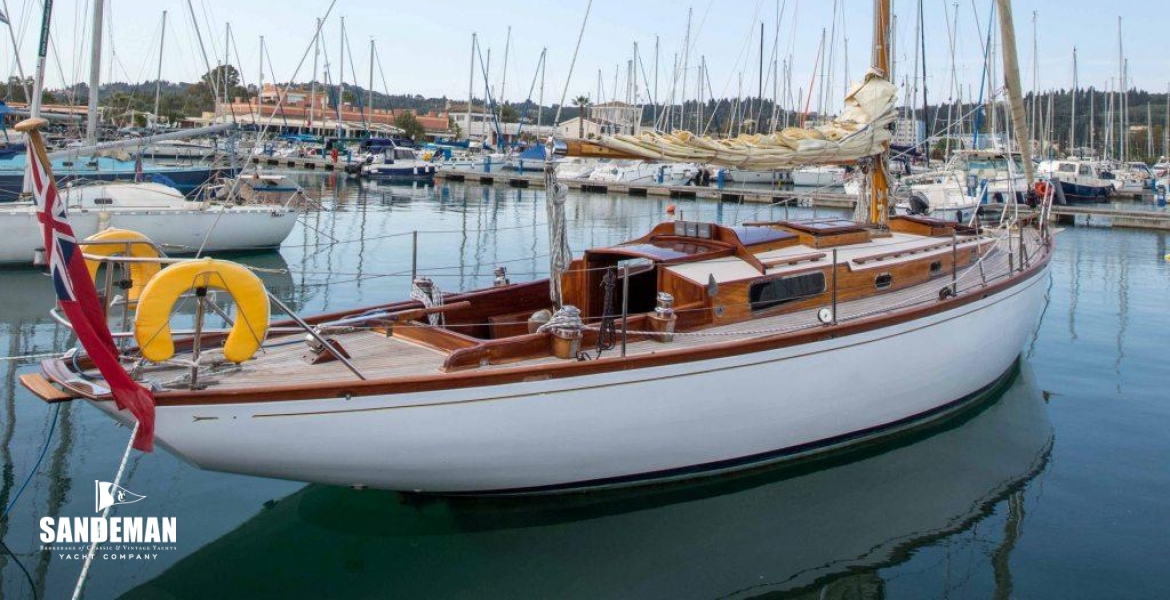
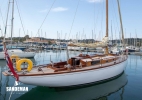
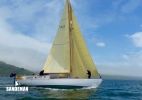
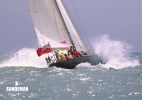
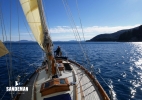
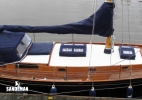
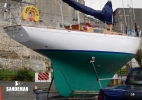
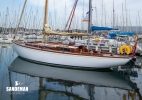
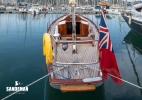
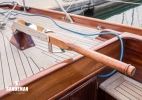
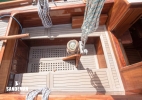
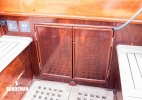
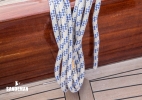
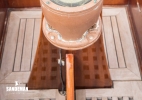
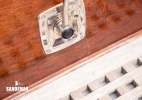


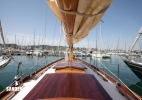
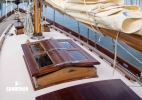
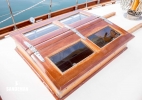
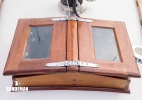
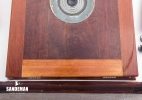
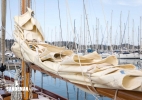
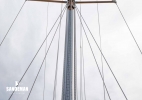
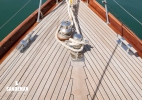
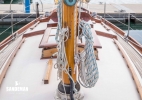
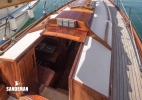

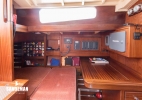
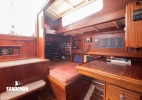
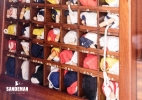
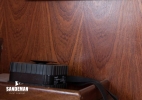
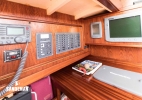
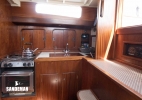
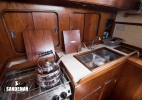
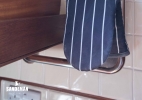
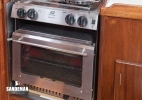
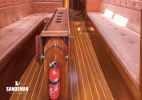
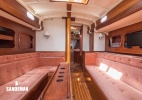
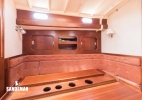

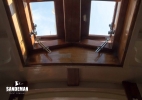
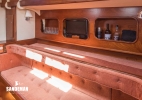
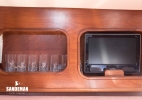

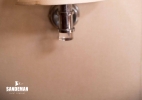
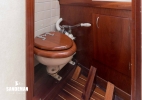
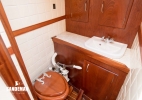
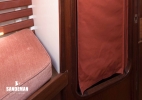
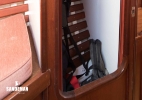
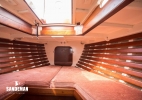
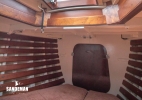
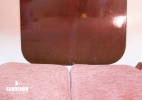
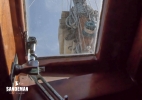
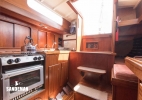
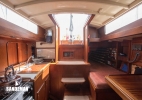
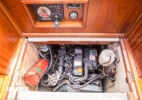
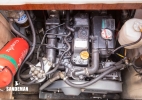
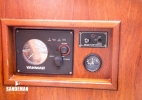
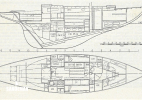
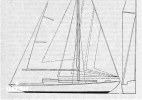
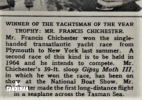
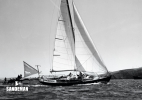
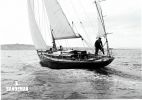

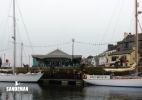
| Designer | Robert Clark |
|---|---|
| Builder | John Tyrrell & Son |
| Date | 1959 |
| Length overall | 38 ft 8 in / 11.79 m |
| Length deck | 38 ft 8 in / 11.79 m |
| Length waterline | 24 ft 0 in / 7.32 m |
|---|---|
| Beam | 10 ft 0 in / 3.04 m |
| Draft | 6 ft 5 in / 1.95 m |
| Displacement | 8 Tonnes |
| Construction | Wood, plank on frame |
| Engine | Yanmar 3JH4E 29hp Diesel |
|---|---|
| Location | United Kingdom |
| Price | Sold |
These details are provisional and may be amended
Few yachts come with such a back story as GIPSY MOTH III's - winner of the first Singlehanded Transatlantic Yacht Race in 1960. Her first owner (later Sir) Francis Chichester's exploits with her, and successor GIPSY MOTH IV, are such a solid part of British maritime history; in the late 1960s boats and man became household names. It's this that has motivated subsequent owners to feel compelled to lavish just deserts on this well proven Robert Clark design, her present owner being no exception having put her through a recent major refit including a new deck and a thoroughly updated but in-keeping new interior. GIPSY MOTH III offers a wonderful opportunity to own a very practical, comfortable, and unquestionably able piece of British maritime history.
Interested in GIPSY MOTH III in more detail.
One of the most famous yacht names in history owes its origins to Sir Francis Chichester’s previous life as an aviator, particularly as a pioneer of developments in aerial navigation. In a way, GIPSY MOTH III might really have been named GIPSY MOTH IV as “I” and “II” were de Havilland Gipsy Moth biplanes. Chichester took up sailing after the second world war with the purchase of a pretty Whisstocks of Woodbridge designed and built sloop he renamed GIPSY MOTH (II) after his second plane in which he’d flown solo half way round the world in 1930.
Never one to do anything by halves, and finding himself living in London next to the Royal Ocean Racing Club, he's said to have walked along and asked how to start ocean racing; the rest is history. GIPSY MOTH (II) had never been designed with far horizons in mind, as Chichester had perhaps discovered while taking on deep sea competitive adventures that might have shocked its architect. But he learned fast and got fast, though at the expense of much comfort. It was at the end of one particularly boisterous mid-1950s Cowes-Dinard race that Chichester’s wife, Shiela, proposed a more comfortable boat, and GIPSY MOTH III was conceived, as recounted by her captain: “sketched on the back of an envelope...” and “passed to Robert Clark...”
Concept and design were made reality at Arklow, County Wicklow, Ireland, by the John Tyrrell & Son yard, which since the 1930s, and in particular under the post second war leadership of naval architect and RORC member Jack Tyrrell, had gained a significant number of orders for yacht construction to drawings by some of England's best known designers, built alongside the yard's bread and butter work of fishing vessels, pilot cutters and other commercial craft, and Jack Tyrrell's own yacht designs - all beautifully built.
According to retired Beaulieu River Harbourmaster and long time friend, Bill Grindley, GIPSY MOTH III was to become, “Sir Francis’ favourite yacht, his most personal one”. Putting serious illness behind him, Chichester won the first Singlehanded Transatlantic Race with her in 1960, and in 1962, after rig optimisation by John Illingworth, set a solo east to west transatlantic record - arriving in the USA on 4th July. In 1964 Chichester and GIPSY MOTH III again took on the Singlehanded Transatlantic race, beaten into second place by Eric Tabarly’s PEN DUICK II, but beating their own 1962 record. The passage home was boat and owner's 6th crossing in 5 seasons.
After the 1966 delivery of her Illingworth-designed record breaking circumnavigation successor, GIPSY MOTH III began a series of ownerships, one of whom apparently ended up buying her at a 1981 Bonhams auction having arrived from Switzerland to bid on furniture. This second phase of her life culminated in rescue from Gibraltar in 1991 from where she’d been purchased in poor condition by Roland Machin, an old school friend of Chichester’s son, Giles. She was shipped to Venice for restoration by Cantiere Nautico dei Fratelli Marchi di Campalto and on relaunching embarked on an ambitious 1990s sailing programme of attending classic regattas including Antigua in 1994 and La Nioularge in 1995.
From 2001 she was berthed at Musée Maritime, La Rochelle, France, and in 2005 came into present ownership, the same year she attended the start of the OSTAR.
Since 2005 GIPSY MOTH III has enjoyed a programme of upgrades culminating in a major refit at Plymouth by RB Shipwrighting followed by a period of family cruising in western Greece and recent return to UK waters.
[Quotations are from Ian Strathcarron's highly recommended book, "Never Fear: Reliving the Life of Sir Francis Chichester" (Unicorn, 2016)]
GIPSY MOTH III’s first major refit/ restoration was undertaken in the early 1990s at Venice by Cantiere Nautico dei Fratelli Marchi di Campalto.
Under present ownership she has enjoyed a long period of major upgrades in between use, in particular 2008-2012 by RB Shipwrighting, then of Plymouth, with new deck, cockpit, interior, systems and powering.
- Carvel mahogany planking on oak frames
- Stainless steel pushpit with stern light and GPS antenna
- Teak laid deck on plywood substrate
- Mahogany covering board
- Stainless steel stanchion bases, stanchions and double guard wires
- Taffrail with mooring fairleads at each corner and step plate
- Taffrail fairs to capping rail on top of raised toerail inset slightly from sheerstrake
- Through-transom boarding step
- Stainless steel stanchion bases, stanchions and double guard wires
- Central aft deck mooring cleat
- Stainless steel backstay chainplate
- Rudder head chock with stainless steel rudder stock to tiller fitting
- Iroko tiller with Raymarine tiller pilot fitting
- Mahogany cockpit coaming and capping rail
- Access doors to lazarette at aft cockpit bulkhead
- Shore power socket
- Vented gas bottle locker
- Cockpit sole mounted pedestal for binnacle and mainsheet winch
- Teak laid seats each side of cockpit
- Vented gas locker under to port and 2 x lockers under to starboard
- 2 x Anderson 28ST self tailing foresail sheet winches
- 2 x Anderson 40ST self tailing foresail sheet winches
- Controls for windlass and bowthuster at cockpit aft starboard
- 1 x stainless steel track each side at covering board; s/s cars for both genoa and staysail
- Low level cabin trunk; mahogany uprights; chromed ports; painted plywood roof
- Slightly raised doghouse; painted plywood roof; mahogany garaged companionway hatch
- Instruments mounted on sprayhood base washboards
- Sprayhood fittings at aft corners
- Butterfly skylights for saloon and forecabin; forehatch to forecabin with bullseye prism
- Mahogany grabrail each side of doghouse and trunk top
- ECS Ventlite ventilator for heads
- Foredeck mooring bollard incorporating inner forestay chainplate
- 2x mooring cleats
- Vetus electric windlass for chain and rope
- Capping rail forward fairs out over knight heads; mooring fairlead each side of stem
- Stainless steel pulpit with port and starboard navigation lights
- CQR anchor with 30m chain, 20m rope
Accommodation for 6 in 3 cabins
Access from companionway hatch via engine box step and two more steps
- All steps staggered
- Holly inset teak ply cabin sole
- Mahogany finished furniture throughout - all new at recent refit
Doghouse port
- Navigation area with lift lid chart table, quarter berth head being seat
- Drawer and locker under
- Instruments and switchboards, plotter, signal flag stowage
- Quarter berth aft of navigation area
Doghouse starboard
- Galley with Plastimo Neptune 2500 gimballed gas 2-burner hob/ grill/ oven
- Frigoboat fridge
- Fiddled work surfaces
- Stowage lockers under and outboard
- Misc kitchenware: dishes, mugs, glasses, cutlery, coffee pot, kettle
- 1.5 bowl stainless steel sink with pressure hot and cold water and seawater hand pump
- Wooden tops for sinks
- Oven glove dish cloth rail
- 2 x 220V UK sockets at galley
- Downlighters in side deck head
- Battery charge indicator
- Gas alarm
- Cabin heating (Eberspacher) control
Forward to saloon with grabrails at bulkhead
- Port “U” upholstered settee offset to port; stowage outboard and under
- Fiddled folding table offset to port with cup
- Starboard upholstered settee with stowage under.
- Upholstered pilot berth outboard; stowage outboard for glasses, bottles and TV
- “Cabin” reading lamps at aft bulkheads; shade lamps at forward bulkhead
- Sideboard with locker outboard to starboard forward saloon opposite heads
- 220V UK sockets
Forward to lobby with tiled heads compartment to port and hanging locker to starboard
- Baby Blake manual WC with wood seat and lid
- Ceramic inset hand basin with hot and cold pressurised water supply
- Stowage under sink and outboard
- Downlighter in side deck head
- Mirror
Forward to forecabin
- Upholstered V-berths with slatted hull lining
- Stowage under
- Butterfly skylight and forehatch escape/ entrance
- Access forward to chain locker
Masthead cutter/ sloop rig with removable inner forestay
- Aluminium mast, “comb” painted for spruce appearance
- Wood boom
- Aluminium newer spinnaker boom with deck stowage chocks
- Stainless steel running rigging
- Extra chainplates for running backstays (not presently in use)
- Chromed bronze bottle screws
- 2 x Harken roller-furling for headsails
- Hood mainsail with slab reefing and lazyjacks
- Hood genoa and staysail
- Spinnaker
- 3 x Traditional handle in slot bronze halyard winches at mast
- 2 x Spinnaker pole mast tracks
- Blue acrylic sprayhood, hatches, skylights and mainsail boom covers
- Yanmar 3JH4E 29hp Diesel
- Fixed three-bladed offset propeller
- Vetus electric bow thruster
- 220V Shore power supply with sockets at galley and saloon
- Pressure water system
- Eberspacher blown air heating
- 3 x 100ah batteries (engine – both – domestic)
- 1 x battery for bow thrusters / windlass
- Solar battery charger (requires new solar panel)
- Fuel tank – capacity TBA
- Water tank – capacity TBA
Analogue
- Binnacle mounted steering compass
- Aries self steering vane gear
Electric/ Electronic
- Navigation lights including tricolour at masthead
- Raymarine tiller pilot
- Raymarine radar
- Raymarine c120 chart plotter/ multifuncion display
- Raymarine ST 70 instruments – wind depth autopilot
Communications
- ICOM IC-M505 VHF Radio
- Navtex: McMurdo ICS Nav6
- Firdell "Blipper" radar reflector
- Radar
- Waypoint Offshore valise life raft (capacity and service info TBA)
- Auto fire extinguisher in engine space
- Manual extinguishers at navigation area and saloon table
- Fire blanket at navigation area
- 2 x “U” lifebelts
Contact us to discuss GIPSY MOTH III in more detail.
These particulars have been prepared from information provided by the vendors and are intended as a general guide. The purchaser should confirm details of concern to them by survey or engineers inspection. The purchaser should also ensure that the purchase contract properly reflects their concerns and specifies details on which they wish to rely.